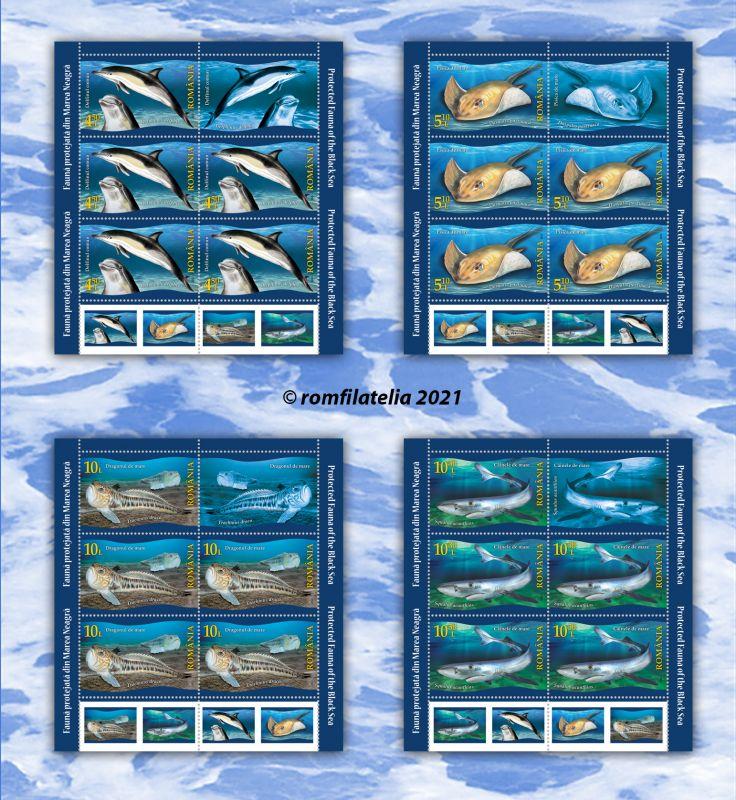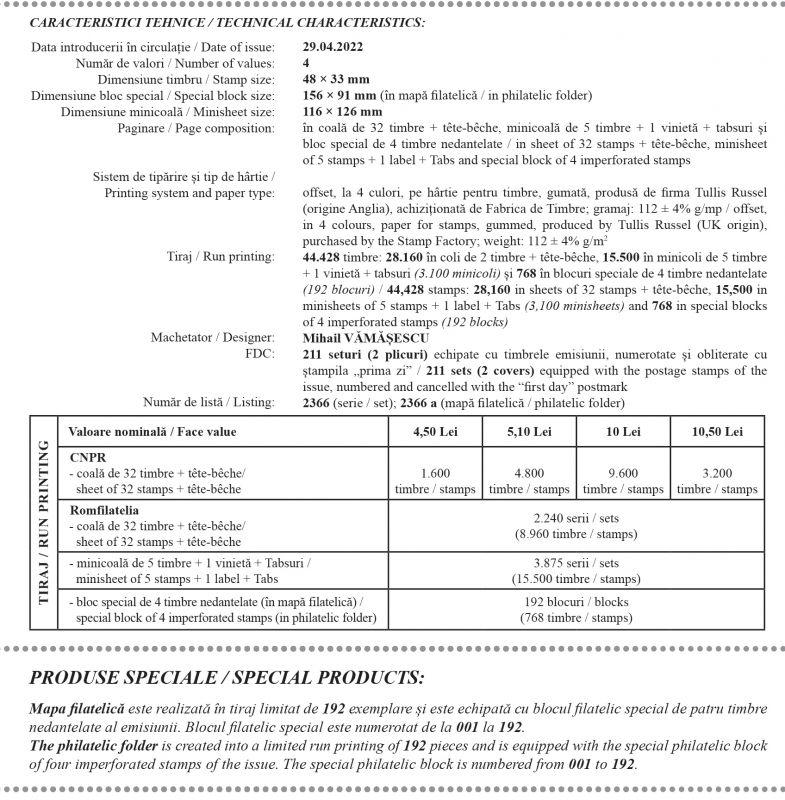 Romfilatelia continues the series of issues dedicated to Fauna and introduces into circulation on Friday, April 29th, this year, the postage stamps issue Protected fauna of the Black Sea.
Romfilatelia continues the series of issues dedicated to Fauna and introduces into circulation on Friday, April 29th, this year, the postage stamps issue Protected fauna of the Black Sea.
Uniqueness of the Black Sea ecosystem and its species
The Black Sea has its own biological characteristics, with peculiarities due to the genesis and paleogeographic past of the Pontic basin, its geographical position and the hydrological characteristics of the tributary rivers. The smaller range of species, compared to the spectacular diversity of other seas and oceans, has given this semi-enclosed aquarium the description of the “impoverished pocket of the Mediterranean”. At present, the Pontic ecosystem is in a fragile state of equilibrium, with prospects for gradual recovery, being home to many vulnerable species, with populations still under the sign of uncertainty.
Common dolphin – Delphinus delphis (Barabasch-Nikiforov, 1953), is illustrated on the stamp with the face value of Lei 4.50.
Popular names: common dolphin
Description: The rostrum is long (10-20 cm) and has 40-45 conical teeth on each half of the jaw. The dorsal fin is high, sickle-shaped and sharp, located in the middle of the body, and the pectoral fins are short and broadly sickle-shaped; the caudal fin is concave, with a well-marked median notch. The body colour is bluish-grey to brown on the back, with a V-shaped side border. A pigmented band joins the lower jaw with the insertion of the pectoral fins. The dorsal fin, the pectoral fins and the caudal fin are grey in colour.
Biology and ecology: it is usually found in the offing areas, in large groups. It is present all year round in the Romanian territorial waters of the Black Sea, in groups of 10-15 individuals, couples or isolated specimens and approaches the coast especially in summer, in August. It swims very fast, reaching speeds of about 50 km/h. It performs short dives and breathes frequently on the surface at 1/3 second intervals. It populates maximum depths of 70 meters. Sexual maturity is reached at the age of 2, and the duration of gestation is 10 months. The maternal instinct is very developed. Longevity was estimated at 25-30 years. The basic food is small pelagic fish (European sprat, anchovy, Black Sea sprat) and crustaceans, but often other species of fish have been noticed in their stomachs – horse mackerel, merling, bluefish, golden grey mullet, Black Sea shad, red mullet and molluscs. It performs regular migrations, influenced by seasonal change of food.
Conservation status: Vulnerable (VU)
Common stingray – Dasyatis pastinaca (Linnaeus, 1758), is depicted on the stamp with the face value of Lei 5.10.
Popular names: common stingray
Description: The body has a rhombus shape and a length of 60-70 cm, exceptionally even 2 m, and a weight of 6-16 kg. The tail is as long as a whip. The dorsal fin is replaced by 1-2 toothed spikes on the edge. Injuries caused by caudal spines can be extremely dangerous. The head is not separate from the body. The edge of the body is occupied by the pectoral and ventral fins. The skin is smooth. Colour – greyish-black or olive-green on the back, and dirty white on the abdomen.
The common stingray is a cartilaginous fish related to the shark. It lives in the region of warmer water shores. In our country, it approach the coast when the water reaches 12°C, looking for a place on the sandy bottoms and retreating to the depths when the water cools.
Greater weever Trachinus draco (Linnaeus, 1758), is represented on the stamp with the face value of Lei 10.
Popular names: greater weever, T. draco
Description: It has an elongated, compressed body, reaching 30-40 cm, covered with relatively small scales. It has small scales on the cheeks and opercula. The eyes are set sideways, looking up. The snout is very short, with two plates pointing downwards. Large, upper mouth, with the upper lip interrupted in the middle. Teeth placed in a single row on the jaws. The lateral line descends into the region of the tail and often contains lateral branches. The spines of the first dorsal fin and the sharp edges of the opercula are very poisonous, their stings causing serious disorders in the body. The colour is generally reddish-grey. The operculum features blue oblique stripes. The sides of the body have yellow stripes. White abdomen with yellow stripes. Marine specimen, but which also supports brackish waters. It lives near the coast, sitting buried in the sand, leaving outside only its eyes, which move carefully, watching the prey. Common in the Black Sea. It breeds in June-July, the hatchling coming from fertilized eggs quite quickly. The food of the greater weever consists of fish (especially turbot spawn), shrimp or worms.
Conservation status: Least Concern (LC) (IUCN)
Spiny dogfish (Mud shark) – Squalus acanthias (Linnaeus, 1758), is illustrated on the stamp with the face value of Lei 10.50.
Popular names: mud shark, spiny dogfish
Description: Compared to ocean sharks, the spiny dogfish, the shark specific to the Black Sea, has a small size. The size reached by males, 1-1.5 m, is smaller than that of females, which reach up to 1.7 m. The weight of the specimens ranges from 6 to 14 kg. The skin is covered with small, placoid scales. Both dorsal fins are preceded by a spike. The mouth is placed ventrally under the snout. The teeth are sharp, arranged in 6 rows, with the tips bent from the middle in the direction of the corners of the mouth. The eyes have no membrane (eyelid). The gill cuts are small and placed in front of the pectorals. The grey-bluish shade predominates in the body colouration, the back and the lateral parts being pigmented with a variable number of bluish or white spots, more accentuated in the young specimens. Its belly is white-yellowish. It is usually reported at sea at a depth of 50-70 m, in the mityloid-phaseolinoid zone. Being adapted to life in cold waters, spiny dogfishes do not have an intense metabolism and have a very slow growth rate. Their longevity is not known exactly. Some estimates indicate the age of 35-40 years, but there are also specimens that live up to 50-75 years. The slow growth, the late sexual maturity and the fact that females produce less than 10 pups on average per year make it very difficult for large spiny dogfish populations to recover. Fearful predator, it feeds on fish such as anchovies, Pinchuk’s goby, blue mackerel, horse mackerel, etc.
Conservation status: Vulnerable (VU) (IUCN)
Romfilatelia thanks the representatives of the Ministry of Environment, Waters and Forests, the specialists of the National Institute for Marine Research and Development “Grigore Antipa” Constanța and the National Museum of Natural History “Grigore Antipa”, for the documentary and photographic support provided to the development of this postage stamps issue.



